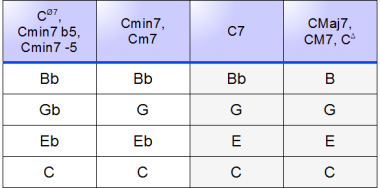Half-Diminished 7th Chord
Yes, the name of this chord is the Half-Diminished 7th chord. Most people do not acknowledge it's existence, and yet is is a very important chord in music theory. Furthermore, it is not difficult to describe using the Triad/Interval method. It's construction, Diminished/Minor, fully indicates which notes make up the chord (as well as give a clue as to why it is called a Half-Diminished chord).
As an example, let's form a D Half-Diminished 7th chord.
- A Half-Diminished 7th chord is made up of a Diminished triad, and a Minor 7th interval.
- The name of the chord gives us the root, that is, D.
- We know that a D Diminished triad is made up of D, F, and Ab.
- The Minor 7th Interval above D is C.
- Therefore, the notes D, F, Ab, and C make up the D Half-Diminished 7th chord.
 D Half-Dim 7th |
Let us follow the same procedure again to form a B Half-Diminished 7th chord.
- A Half-Diminished 7th chord is made up of a Diminished triad, and a Minor 7th interval.
- The name of the chord gives us the root, that is, B.
- We know that a B Diminished triad is made up of B, D, and F.
- The Minor 7th Interval above B is A.
- Therefore, the notes B, D, F, and A make up the B Half-Diminished 7th chord.
 B Half-Dim 7th |
We will now add to our chart the Diminished/Minor construction of the Half-Diminished 7th Chord. Please note that the symbol for the Half-Diminished Chord is a circle with a line through it (i.e., Bb Half-Diminished 7th is Bbø7). You may not have this "slashed circle" on your keyboard, so a common way to write the chord is also "Bbmin7-5". This rather long way of writing the chord name means, "Start with a Bbmin7 chord, and flat the fifth." When hand writing chord symbols, most people prefer the "slashed circle" method, but most printed music and lead sheets will use the longer, "min7-5" description. (This also brings up an interesting observation: the only difference between a Minor 7th chord and a Half-Diminished 7th chord is that the latter has a flatted fifth.)

Here is the chart as applied to a C chord:

